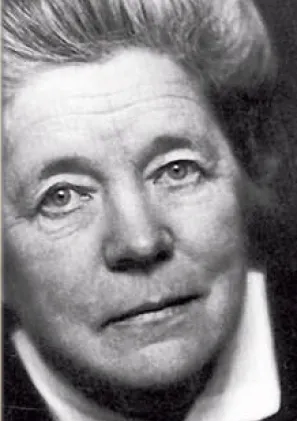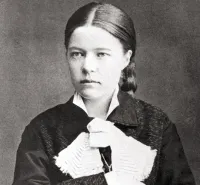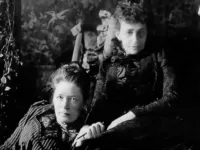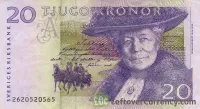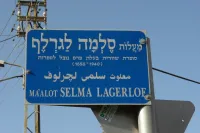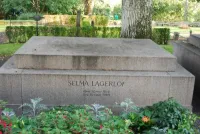Biography
1858 - 1940
“There is always a third possibility, as long as you have the ability to find it.”
– Selma Lagerlöf
Born in Värmland in western Sweden, Selma Lagerlöf was a sickly child and grew up with a love of reading. She won a publishing contract with her first novel, Gosta Berling's Saga (1891) while working as a schoolteacher. Three years later she published her second book and met Jewish writer Sophie Elkan who became her friend and companion. Her journey to Italy with Elkan prompted her novel The Miracles of the Antichrist (1899). A visit to the American Colony in Jerusalem became the inspiration for her acclaimed work Jerusalem (1901) - a two-part novel about Swedish peasants who immigrated to the Holy Land. The book is dedicated to "Sophie Elkan, my companion in life and letters." Her additional works include short story collections, memoirs, nonfiction, children's books such as her enormously popular The Wonderful Adventures of Nils (1907); and novels such as The Emperor of Portugal (1914) and The Outcast (1918). The Swedish Academy awarded her its Gold Medal in 1904; and in 1909 Lagerlöf became the first female writer to win the Nobel Prize for Literature. Five years later she became the first female member of the Swedish Academy. In 1933, in Elkan's honor, Lagerlöf donated one of her Christ legends for publication to earn money to support Jewish refugees from Nazi Germany. In 1940, she sent her Nobel Prize medal and the Gold Medal from the Swedish Academy to the government of Finland to help raise money to fight the Soviet Union. She died on March 16, 1940 in Varmland at age 81 – several days after suffering a cerebral hemorrhage. The intimate Lesbian Swedish letters between Lagerlöf and Elkan, which tell of their passionate love story from 1894 until Elkan's death in 1921, were published in 1992 as You Teach Me to Be Free. Since 1992, her portrait has been featured on the Swedish 20 kroner bill.
1858 - 1940
“There is always a third possibility, as long as you have the ability to find it.”
– Selma Lagerlöf
Born in Värmland in western Sweden, Selma Lagerlöf was a sickly child and grew up with a love of reading. She won a publishing contract with her first novel, Gosta Berling's Saga (1891) while working as a schoolteacher. Three years later she published her second book and met Jewish writer Sophie Elkan who became her friend and companion. Her journey to Italy with Elkan prompted her novel The Miracles of the Antichrist (1899). A visit to the American Colony in Jerusalem became the inspiration for her acclaimed work Jerusalem (1901) - a two-part novel about Swedish peasants who immigrated to the Holy Land. The book is dedicated to "Sophie Elkan, my companion in life and letters." Her additional works include short story collections, memoirs, nonfiction, children's books such as her enormously popular The Wonderful Adventures of Nils (1907); and novels such as The Emperor of Portugal (1914) and The Outcast (1918). The Swedish Academy awarded her its Gold Medal in 1904; and in 1909 Lagerlöf became the first female writer to win the Nobel Prize for Literature. Five years later she became the first female member of the Swedish Academy. In 1933, in Elkan's honor, Lagerlöf donated one of her Christ legends for publication to earn money to support Jewish refugees from Nazi Germany. In 1940, she sent her Nobel Prize medal and the Gold Medal from the Swedish Academy to the government of Finland to help raise money to fight the Soviet Union. She died on March 16, 1940 in Varmland at age 81 – several days after suffering a cerebral hemorrhage. The intimate Lesbian Swedish letters between Lagerlöf and Elkan, which tell of their passionate love story from 1894 until Elkan's death in 1921, were published in 1992 as You Teach Me to Be Free. Since 1992, her portrait has been featured on the Swedish 20 kroner bill.
Demography
Demography
Gender Female
Sexual Orientation Lesbian
Gender Identity Cisgender
Ethnicity Caucasian/White
Faith Construct Protestant
Nations Affiliated Sweden
Era/Epoch First-wave Feminism (1848-1930) Gilded Age (1865-1900) Progressive Era (1890-1920)
Field(s) of Contribution
Author
Education
Commemorations & Honors
Home Named Mårbacka Preserved as a Museum
Jerusalem Street Named After Lagerlöf
Swedish Academy Gold Medal Awardee (1904)
Doctor of Letters Degree From Uppsala University (1907)
First Woman Awarded the Nobel Prize for Literature (1909)
First Woman Member of the Swedish Academy (1914)
Honorary Doctorate From University of Greifswald's Faculty of Arts (1928)
Visage Depicted on Swedish 20 Kroner Bill (1992-present)
Google Doodle Commemorating Selma Lagerlöf's 155th Birthday (2013)
Demography
Gender Female
Sexual Orientation Lesbian
Gender Identity Cisgender
Ethnicity Caucasian/White
Faith Construct Protestant
Nations Affiliated Sweden
Era/Epoch First-wave Feminism (1848-1930) Gilded Age (1865-1900) Progressive Era (1890-1920)
Field(s) of Contribution
Author
Education
Commemorations & Honors
Home Named Mårbacka Preserved as a Museum
Jerusalem Street Named After Lagerlöf
Swedish Academy Gold Medal Awardee (1904)
Doctor of Letters Degree From Uppsala University (1907)
First Woman Awarded the Nobel Prize for Literature (1909)
First Woman Member of the Swedish Academy (1914)
Honorary Doctorate From University of Greifswald's Faculty of Arts (1928)
Visage Depicted on Swedish 20 Kroner Bill (1992-present)
Google Doodle Commemorating Selma Lagerlöf's 155th Birthday (2013)
Resources
Resources
Edström, Vivi. Selma Lagerlöf. Boston: Twayne, 1984.
Holm, Birgitta. Selma Lagerlöf och ursprungets roman. Stockholm: Norstedts, 1984.
Munck, Kerstin. "Makt, sexualitet och gränsöverskridanden hos Selma Lagerlöf." Tidskrift för litteraturvetenskap 2 (1998): 31-38.
Stenberg, Lisbeth. "Text och förklädnad." Lambda nordica 2 (1996): 34-47.
Torpe, Ulla. Orden och jorden. Stockholm: Gidlunds, 1992.
http://womenshistory.about.com/od/selmalagerlof/a/selma_lagerlof.htm
http://en.wikipedia.org/wiki/Selma_Lagerlof
https://artlark.org/2019/11/20/selma-lagerlofs-literary-lesbian-liaisons/
http://sfbaytimes.com/selma-lagerlof-a-nobel-mind/
http://blog.pshares.org/index.php/an-unconventional-nobel-laureate/
https://www.nobelprize.org/prizes/literature/1909/lagerlof/biographical/
Resources
Edström, Vivi. Selma Lagerlöf. Boston: Twayne, 1984.
Holm, Birgitta. Selma Lagerlöf och ursprungets roman. Stockholm: Norstedts, 1984.
Munck, Kerstin. "Makt, sexualitet och gränsöverskridanden hos Selma Lagerlöf." Tidskrift för litteraturvetenskap 2 (1998): 31-38.
Stenberg, Lisbeth. "Text och förklädnad." Lambda nordica 2 (1996): 34-47.
Torpe, Ulla. Orden och jorden. Stockholm: Gidlunds, 1992.
http://womenshistory.about.com/od/selmalagerlof/a/selma_lagerlof.htm
http://en.wikipedia.org/wiki/Selma_Lagerlof
https://artlark.org/2019/11/20/selma-lagerlofs-literary-lesbian-liaisons/
http://sfbaytimes.com/selma-lagerlof-a-nobel-mind/
http://blog.pshares.org/index.php/an-unconventional-nobel-laureate/
https://www.nobelprize.org/prizes/literature/1909/lagerlof/biographical/
